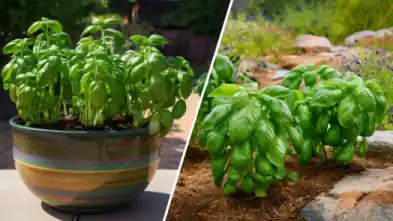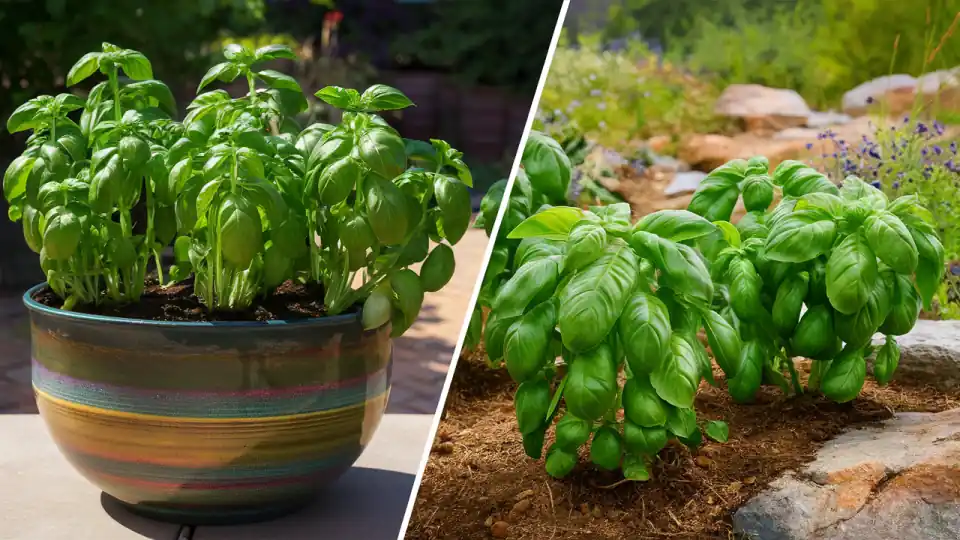Are you ready to embark on a flavorful journey with basil? Whether you’re a seasoned gardener or a beginner, this comprehensive guide will equip you with everything you need to cultivate thriving basil plant right in your own home garden. From choosing the perfect location to mastering harvesting techniques, we’ll cover it all. Let’s dive in and unlock the secrets to growing aromatic basil leaves that elevate your culinary creations! 🌿🌱
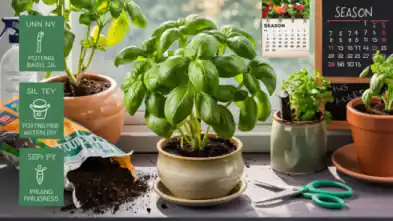
1. Location and Space
Assess Space
Basil plants thrive in well-drained soil and require ample sunlight. When choosing a location, consider the following:
- Sunlight: Basil needs at least 6-8 hours of direct sunlight per day. Place it in a spot that receives adequate sunlight.
- Soil: Well-draining soil with a slightly acidic to neutral pH (around 6.0-7.0) is ideal for basil.
- Space: Each basil plant should have about 12-18 inches (30-45 cm) of space around it. This allows for proper air circulation and prevents overcrowding.
Vertical Gardening
If you’re short on horizontal space, consider vertical gardening options for basil:
- Hanging Baskets: Hang baskets with basil plants near a sunny window or on a balcony railing.
- Wall-Mounted Planters: Install wall-mounted planters to grow basil vertically.
- Tiered Shelves: Use tiered shelves or plant stands to maximize space while growing basil indoors.
Remember to water your basil consistently, keeping the soil evenly moist but not waterlogged. With the right care, you’ll enjoy fresh basil leaves for cooking and garnishing! 🌿
2. Sunlight Requirements for Basil Plants
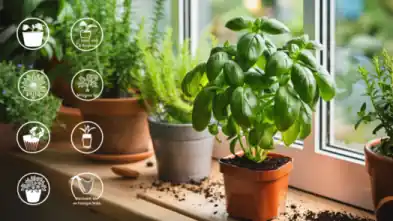
Basil plants have specific sunlight preferences. Here’s what you need to know:
- Full Sun: Basil thrives in full sun, which means it needs at least 6-8 hours of direct sunlight per day. If you’re growing basil outdoors, choose a sunny spot in your garden or on your balcony.
- Partial Shade: While basil prefers full sun, it can tolerate some shade. If you have a partially shaded area, consider growing basil there. Just ensure it still receives a few hours of sunlight daily.
- Full Shade: Basil doesn’t do well in full shade. If you’re growing it indoors, place it near a bright window where it can receive indirect sunlight throughout the day.
Remember to adjust your basil’s location based on its sunlight requirements to ensure healthy growth and flavorful leaves! 🌞🌿
Explore
Comprehensive guide covers everything you need to know about successfully growing arugula.
3. Soil Conditions for Basil Plants
Basil plants thrive in specific soil conditions. Here’s what you need to know:
- Soil Type: Basil grows best in nutrient-rich, well-drained soil. Aim for loamy soil, which provides a balanced environment. Loamy soil has good drainage to prevent root rot and retains enough moisture to keep the plant from drying out. The rich nutrients in loamy soil support lush and fragrant basil growth1.
- Soil pH: Basil prefers a neutral pH. If your soil is too acidic or alkaline, consider adjusting it. Add some rich compost to your garden soil and mix well. You can also incorporate a handful of perlite to improve aeration, drainage, and moisture retention in the soil2.
Remember to provide your basil plants with the right soil conditions to ensure healthy growth and flavorful leaves! 🌿🌱
4. Climate and Microclimates for Basil Plants

Basil plants thrive in specific climate conditions. Here’s what you need to know:
- Temperature Range: Basil grows best and is most productive at temperatures between 70-85°F (21-29°C). They can tolerate temperatures between 50°F (10°C) and 90°F (32°C), but growth is slower at lower temperatures and flowering occurs faster at higher temperatures1.
- Frost Sensitivity: Basil is sensitive to frost. If the temperature drops below 39°F (4°C), basil may not survive. Consider planting basil in a greenhouse, tunnel house, or indoors if frost is a concern2.
- Sunlight Intensity: Basil needs 6-8 hours of sunlight per day on average. However, adjust the duration based on the season: 8-9 hours in spring and fall, and 5-7 hours in the middle of summer. Plant basil where it receives morning and early afternoon sun, with some shade in the late afternoon and evening to prevent intense sunlight damage1.
Remember to create a microclimate that provides the right temperature and sunlight conditions for your basil plants to thrive! 🌿🌞
5. Planting Methods for basil plant
| Method | Rating | Reason | Expenses | Indoor | Outdoor | Fruit Growth | Maintenance Input | Conclusion |
|---|---|---|---|---|---|---|---|---|
| Seeds vs. Transplants | ⭐⭐⭐ | Seeds offer variety; transplants provide convenience. | Low | Yes | Yes | Moderate | Regular watering | Choose based on preference and patience. |
| Aquaponics | ⭐⭐⭐⭐ | Symbiotic system with fish waste as natural fertilizer. | Moderate | Yes | Yes | High | Monitoring pH | Ideal for sustainable gardening and efficient nutrient use. |
| Back to Eden Gardening | ⭐⭐⭐ | Wood chips retain moisture and gradually release nutrients. | Low | Yes | Yes | Moderate | Mulching | Soil improvement and weed suppression. |
| Biodynamic Gardening | ⭐⭐⭐ | Holistic approach with composting for ecosystem balance. | Low | Yes | Yes | Moderate | Composting | Aligns with nature’s rhythms for overall garden health. |
| Companion Planting | ⭐⭐⭐ | Basil benefits from compatible plant pairings. | Low | Yes | Yes | Moderate | Pest management | Enhances biodiversity and repels pests. |
| Raised Bed Gardening | ⭐⭐⭐ | Elevated beds with controlled soil quality. | Moderate | Yes | Yes | Moderate | Soil preparation | Better drainage and soil management. |
| Container Gardening | ⭐⭐⭐ | Flexible and space-saving; suitable for small areas. | Low | Yes | Yes | Moderate | Regular pruning | Ideal for balconies and limited space. |
| Square Foot Gardening | ⭐⭐⭐ | Efficient use of space with organized planting. | Low | Yes | Yes | Moderate | Intensive care | Maximizes yield in limited space. |
| Hydroponic Gardening | ⭐⭐⭐⭐ | Soil-less method with precise nutrient delivery. | High | Yes | Yes | High | Nutrient monitoring | Rapid growth and controlled environment. |
| Hügelkultur | ⭐⭐⭐ | Wood-based mounds improve soil fertility and water retention. | Low | Yes | Yes | Moderate | Soil preparation | Enhances soil structure and moisture retention. |
| Traditional Inground | ⭐⭐⭐ | Classic plot directly in the ground. | Low | Yes | Yes | Moderate | Regular care | Suitable for open garden spaces. |
| Vertical Gardening | ⭐⭐⭐ | Utilizes walls or trellises for space-efficient growth. | Low | Yes | Yes | Moderate | Trellis support | Maximizes vertical space utilization. |
| Edible Landscaping | ⭐⭐⭐ | Integrates basil into landscape design. | Low | Yes | Yes | Moderate | Aesthetic care | Blends functionality and beauty. |
| Window Box Gardening | ⭐⭐⭐ | Convenient for small spaces; grows basil in window boxes. | Low | Yes | Yes | Moderate | Regular watering | Ideal for windowsills and balconies. |
| Lasagna Gardening | ⭐⭐⭐ | Layered organic materials for no-dig planting. | Low | Yes | Yes | Moderate | Layering process | Minimal soil disturbance and weed control. |
| Straw Bale Gardening | ⭐⭐⭐ | Plant directly in straw bales; simple and compostable. | Low | Yes | Yes | Moderate | Watering | Suitable for temporary or experimental setups. |
| No Till Gardening | ⭐⭐⭐ | Minimizes soil disturbance for natural growth. | Low | Yes | Yes | Moderate | Minimal tilling | Promotes soil health and weed prevention. |
Choose the method that aligns with your gardening goals, resources, and available space. Happy gardening! 🌿🌱

6. Seasonal Considerations for Basil Plants
Understanding the seasonal aspects of basil cultivation is essential for successful growth. Let’s explore:
- Fruit and Flower Times:
- Basil Flowers: Basil plants typically produce flowers during late spring to early summer. Regularly pinching off flower buds helps maintain leaf production and prevents premature flowering.
- Fruit (Seeds): If you allow basil flowers to mature, they’ll produce seeds. Harvest seeds when they turn brown and dry. These seeds can be saved for future planting.
- Extending the Season:
- Cold Frames: Extend the growing season by using cold frames. These structures provide protection from frost and allow you to grow basil even during cooler months.
- Indoor Gardening: Bring basil indoors during fall and winter. Place it near a sunny window or use grow lights. Indoor basil can thrive year-round.
Remember to adapt your basil care routine based on the seasons to enjoy fresh leaves and aromatic flavor throughout the year! 🌿🌸

7. Companion Planting for Basil Plants
Companion planting involves strategically pairing plants to enhance growth, deter pests, and improve overall garden health. Let’s explore companion plants for basil:
- Tomatoes (Lycopersicon esculentum):
- Basil Benefits: Basil and tomatoes are excellent companions. Basil repels tomato hornworms and enhances tomato flavor.
- Tomato Benefits: Tomatoes benefit from basil’s pest-repelling properties and thrive when planted nearby.
- Peppers (Capsicum spp.):
- Basil Benefits: Basil deters aphids and spider mites, which can harm pepper plants.
- Pepper Benefits: Peppers and basil create a mutually beneficial environment, promoting growth and flavor.
- Oregano (Origanum vulgare):
- Basil Benefits: Oregano complements basil by repelling pests and enhancing its aromatic properties.
- Oregano Benefits: Oregano benefits from basil’s pest-repelling qualities and adds diversity to the herb garden.
- Chives (Allium schoenoprasum):
- Basil Benefits: Chives deter aphids and protect basil from pests.
- Chive Benefits: Chives and basil create a harmonious pairing, supporting each other’s growth.
- Marigolds (Tagetes spp.):
- Basil Benefits: Marigolds repel nematodes and other soil-borne pests, benefiting basil roots.
- Marigold Benefits: Marigolds enhance soil health and protect neighboring plants.
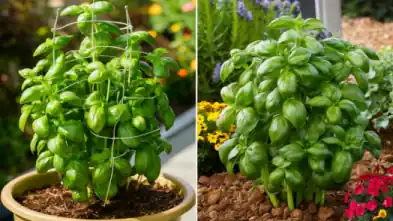
Remember to choose companion plants wisely to create a thriving garden ecosystem where basil flourishes alongside its botanical buddies! 🌿🌼
8. Pest Management for Basil Plants
Keeping basil plants healthy involves effective pest management. Here are natural solutions to common basil pests:
- Aphids:
- Identification: Small, soft-bodied insects that cluster on new growth.
- Natural Control:
- Neem Oil: Spray diluted neem oil on affected leaves to repel aphids.
- Ladybugs: Release ladybugs—they feed on aphids and help control their population.
- Whiteflies:
- Identification: Tiny, white insects that fly around basil plants.
- Natural Control:
- Yellow Sticky Traps: Hang yellow sticky traps near basil to catch whiteflies.
- Beneficial Insects: Encourage lacewings and parasitic wasps—they prey on whiteflies.
- Spider Mites:
- Identification: Tiny red or yellow mites that create fine webs on leaves.
- Natural Control:
- Spray with Water: Regularly spray basil leaves with water to dislodge spider mites.
- Predatory Mites: Introduce predatory mites to feed on spider mites.
- Slugs and Snails:
- Identification: Slimy pests that chew holes in basil leaves.
- Natural Control:
- Beer Traps: Place shallow containers filled with beer near basil plants—slugs are attracted and drown.
- Copper Barriers: Surround basil beds with copper tape or wire to deter slugs.
- Japanese Beetles:
- Identification: Metallic green beetles that skeletonize basil leaves.
- Natural Control:
- Handpick: Remove beetles by hand and drop them into soapy water.
- Nematodes: Apply beneficial nematodes to soil—they attack beetle larvae.
Remember to monitor your basil plants regularly and take preventive measures to keep pests at bay. 🌿🪲
9. Watering and Drainage for Basil Plants
Proper watering and drainage are crucial for healthy basil growth. Let’s dive into the details:
- Watering Wisely:
- Frequency: Water basil when the top inch (2.5 cm) of soil feels dry. Aim for consistent moisture without waterlogging.
- Morning Watering: Water in the morning to allow excess moisture to evaporate during the day.
- Avoid Overhead Watering: Water at the base of the plant to prevent fungal diseases on leaves.
- Drainage Matters:
- Well-Drained Soil: Basil prefers well-draining soil. Amend heavy clay soil with organic matter to improve drainage.
- Elevated Planting: Raised beds or containers with drainage holes prevent waterlogged roots.
- Mulching: Apply a thin layer of organic mulch around basil plants to retain moisture while allowing excess water to escape.
Remember, finding the right balance ensures your basil thrives—neither parched nor waterlogged! 🌿💧

10. Weeding and Maintenance for Basil Plants
Maintaining a healthy basil garden involves proper weeding and regular care. Let’s delve into the details:
- Tidy Garden:
- Weeding: Regularly remove weeds around basil plants. Weeds compete for nutrients, water, and sunlight, affecting basil growth.
- Mulching: Apply organic mulch (such as straw or wood chips) around basil to suppress weeds and retain moisture.
- Pruning Tips:
- Pinching: Pinch off the top leaves regularly to encourage bushier growth. This prevents basil from becoming too leggy.
- Deadheading: Remove spent flowers promptly to redirect energy toward leaf production.
Remember, a well-maintained basil garden yields flavorful leaves for your culinary creations! 🌿✂️
11. Harvesting Techniques for Basil Plants
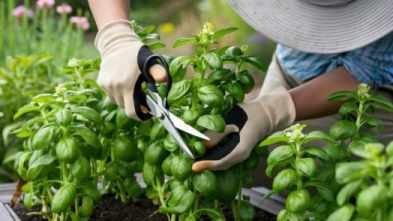
Harvesting basil at the right time ensures maximum flavor and productivity. Let’s explore the techniques:
- Peak Flavor Harvest:
- Timing: Harvest basil leaves when they are young and vibrant, just before flowering. The flavor is most intense at this stage.
- Method: Pinch off individual leaves or cut stems just above a leaf node (where new growth emerges).
- Frequency: Regularly harvest to encourage bushier growth and prevent flowering..
- Continuous Harvest:
- Repetitive Harvesting: Basil plants can be harvested repeatedly throughout the growing season.
- Leaf-by-Leaf: Rather than harvesting entire stems, pick leaves as needed. This allows the plant to keep producing fresh foliage.
- Avoid Overharvesting: Leave at least one-third of the plant intact to maintain its vitality.
Remember, harvesting basil promptly and judiciously ensures a steady supply of aromatic leaves for your culinary delights! 🌿🍽️

12. Soil Health and Maintenance for Basil Plants
Maintaining healthy soil is essential for robust basil growth. Let’s explore soil-related aspects:
- Drainage Matters:
- Importance: Proper drainage prevents waterlogged roots and root rot.
- Tips:
- Use well-draining soil or amend heavy soil with organic matter.
- Elevate containers or raised beds to ensure excess water drains away.
- Fertilize Right:
- Organic Fertilizers: Opt for natural options like compost, aged manure, or fish emulsion.
- Application:
- Side-dress basil with compost during the growing season.
- Avoid excessive nitrogen, which can lead to leggy growth.
- Crop Rotation:
- Why Rotate? Prevent soil depletion and reduce pest buildup.
- Basil Rotation:
- Avoid planting basil in the same spot consecutively.
- Rotate with other herbs or vegetables to maintain soil health.
Remember, healthy soil supports thriving basil plants and flavorful leaves! 🌿🌱
13. Aesthetic Appeal for Basil Plants
Creating an aesthetically pleasing basil garden enhances both visual impact and your gardening experience. Let’s explore ways to elevate the beauty of your basil plants:
- Visual Impact:
- Arrangement: Group basil plants together for a lush, cohesive look. Consider planting them in clusters or rows.
- Companion Plants: Pair basil with other herbs or colorful flowers. The contrast adds interest to your garden.
- Colors and Textures:
- Leaf Varieties: Basil comes in various leaf shapes and colors. Mix green basil with purple varieties like ‘Purple Ruffles’ or ‘Dark Opal’ for a striking display.
- Texture Contrast: Combine basil’s smooth leaves with coarser-textured plants like rosemary or sage.
Remember, a well-designed basil garden not only delights the senses but also inspires your culinary creativity! 🌿🎨

14. Sustainability Practices for Basil Plants
Promoting sustainability in your basil garden benefits both the environment and your harvest. Let’s explore eco-friendly practices:
- Chemical-Free Approach:
- Organic Methods: Avoid synthetic pesticides or herbicides. Instead, use natural solutions like neem oil, garlic spray, or companion planting to deter pests.
- Compost: Create your own compost using kitchen scraps and yard waste. Nutrient-rich compost enriches the soil and supports basil growth.
- Beneficial Insects:
- Pollinators: Encourage bees, butterflies, and other pollinators. They enhance basil flowering and fruit set.
- Ladybugs and Lacewings: Release these beneficial insects—they prey on pests like aphids and whiteflies.
Remember, sustainable practices not only benefit your basil but also contribute to a healthier ecosystem! 🌿🌎
15. Disease Prevention: Proper Spacing for Basil Plants
Spacing matters when it comes to preventing fungal issues in basil plants. Here’s why:
- Air Circulation:
- Proper spacing allows air to circulate freely around basil plants.
- Good airflow reduces humidity and prevents moisture buildup, which can lead to fungal diseases.
- Fungal Prevention:
- Basil is susceptible to diseases like downy mildew and powdery mildew.
- Spacing plants adequately ensures that leaves dry quickly after rain or watering, minimizing the risk of fungal infections.
Recommendation:
- Space basil plants approximately 12-18 inches (30-45 cm) apart.
- Avoid overcrowding to maintain healthy foliage and prevent fungal issues.
Remember, a well-spaced basil garden promotes vigorous growth and disease resistance! 🌿🌱
16. Adaptability to Changes for Basil Plants
Basil plants exhibit remarkable adaptability, but it’s essential to prepare for weather fluctuations and extreme conditions:
- Weather Preparedness:
- Temperature Swings: Basil can tolerate a range of temperatures, but sudden shifts can stress the plants. Monitor weather forecasts and protect basil during extreme cold or heat.
- Covering: Use row covers or cloths to shield basil from frost or intense sunlight.
- Extreme Conditions:
- Frost Protection: Basil is sensitive to frost. If frost is expected, cover plants with blankets or move potted basil indoors.
- Heatwaves: Basil may wilt during heatwaves. Provide shade during peak sun hours and ensure consistent watering.
Remember, proactive care ensures your basil thrives even when faced with changing conditions! 🌿🌦️
17. Container vs. Ground Planting for Basil
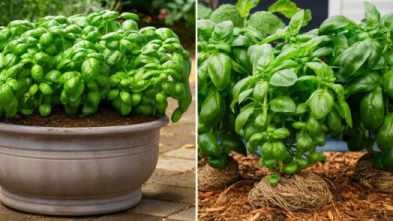
When deciding between container and ground planting for basil, consider the following factors:
- Container Gardening:
- Advantages:
- Small Spaces: Ideal for balconies, patios, or limited areas.
- Mobility: Move containers to optimize sunlight exposure.
- Control: Easier to manage soil quality and drainage.
- Considerations:
- Pot Size: Choose a pot with at least 12-18 inches (30-45 cm) diameter for each basil plant.
- Well-Draining Soil: Use a high-quality potting mix.
- Regular Watering: Containers dry out faster, so monitor moisture levels.
- Advantages:
- Ground Planting (Directly in the Soil):
- Advantages:
- Space: Suitable for larger gardens or raised beds.
- Natural Environment: Basil roots can spread freely.
- Less Maintenance: Once established, basil requires less attention.
- Considerations:
- Soil Preparation: Amend soil with compost for optimal growth.
- Spacing: Plant basil 12-18 inches (30-45 cm) apart.
- Weeding: Regularly remove weeds to reduce competition.
- Advantages:
Remember, both methods can yield abundant basil leaves—choose based on your available space and gardening preferences! 🌿🏡
Conclusion
Certainly! In summary, growing basil successfully involves understanding its specific needs. Choose a sunny location with well-draining soil, and consider vertical gardening options if space is limited. Provide adequate sunlight, and adjust watering to keep the soil consistently moist. Companion planting with tomatoes, peppers, and oregano enhances growth. Regular harvesting ensures flavorful leaves. Remember to maintain soil health, prevent pests, and adapt to changing conditions. Whether in containers or directly in the ground, a thriving basil garden awaits! 🌿🌱
